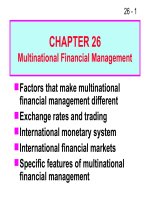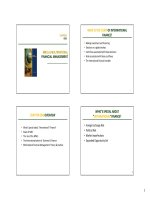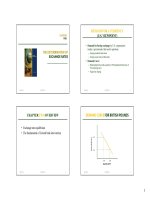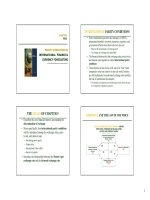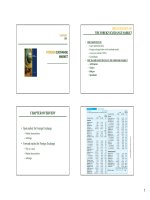Multinational financial management 7th CH13
Bạn đang xem bản rút gọn của tài liệu. Xem và tải ngay bản đầy đủ của tài liệu tại đây (487.18 KB, 18 trang )
Multinational Financial
Management
Alan Shapiro
7th Edition
Power Points by
J.Wiley
& Sons
Joseph F. Greco,
Ph.D.
California State University, Fullerton
1
CHAPTER 13
THE EUROMARKETS
2
CHAPTER OVERVIEW:
I. THE EUROCURRENCY MARKETS
II. EUROBONDS
III.NOTE ISSUANCE FACILITIES AND
EURONOTES
IV. EUOR COMMERCIAL PAPER
V. THE ASIA CURRENCY MARKETS
3
I. THE EUROCURRENCY
MARKETS
THE EUROMARKETS
-the most important international
financial markets today.
A. The Eurocurrency Market
1.
Composed of eurobanks who
accept/maintain deposits of
foreign currency
2.
Dominant currency: US$
4
THE EUROCURRENCY MARKETS
B.
Growth of Eurodollar Market
caused by restrictive US government
policies, especially
1. Reserve requirements on deposits
2. Special charges and taxes
3. Required concessionary loan rates
4. Interest rate ceilings
5. Rules which restrict bank
competition.
5
THE EUROCURRENCY MARKETS
C.
Eurodollar Creation involves
1.
A chain of deposits
2.
Changing control/usage of
deposit
6
THE EUROCURRENCY MARKETS
3.
Eurocurrency loans
a. Use London Interbank Offer
LIBOR as basic rate
Rate:
b. Six month rollovers
c. Risk indicator: size of
margin
between cost and rate charged.
7
THE EUROCURRENCY MARKETS
4. Multicurrency Clauses
a. Clause gives borrower option to
switch currency of loan at
rollover.
b. Reduces exchange rate risk
8
THE EUROCURRENCY MARKETS
5.Domestic vs. Eurocurrency Markets
a.
Closely linked rates by
arbitrage
b.
Euro rates: tend to lower
lending, higher deposit
9
II. EUROBONDS
A. DEFINITION OF EUROBONDS
bonds sold outside the country of
currency
denomination.
1. Recent Substantial Market Growth
-due to use of swaps.
a financial instrument which
gives 2 parties the right to
exchange streams of income
over time.
10
EUROBONDS
2. Links to Domestic Bond Markets
arbitrage has eliminated interest
rate differential.
3. Placement
underwritten by syndicates of
banks
11
EUROBONDS
4. Currency Denomination
a. Most often US$
b. “Cocktails” allow a basket of
currencies
5. Eurobond Secondary Market
-result of rising investor demand
6. Retirement
a. sinking fund usually
b. some carry call provisions.
12
EUROBONDS
7. Ratings
a. According to relative risk
b. Rating Agencies
Moody’s, Standard & Poor
8. Rationale For Market Existence
a. Eurobonds avoid government
regulation
b. May fade as market deregulate
13
THE EUROMARKETS
B.
1.
a.
b.
c.
d.
e.
Eurobond vs. Eurocurrency Loans
Five Differences
Eurocurrency loans use variable
rates
Loans have shorter maturities
Bonds have greater volume
Loans have greater flexibility
Loans obtained faster
14
III. NOTE ISSUANCE FACILITIES
AND EURONOTES
A.
Note Issuance Facility (NIF)
1. Low-cost substitute for loan
2. Allows borrowers to issue own
notes
3. Placed/distributed by banks
15
NOTE ISSUANCE FACILITIES AND
EURONOTES
B. NIFs vs. Eurobonds
1. Differences:
a. Notes draw down credit as
needed
b. Notes let owners determine
timing
c. Notes must be held to maturity
16
IV. EURO-COMMERCIAL PAPER
I. SHORT-TERM FINANCING
A. Euronotes and Euro-Commercial
Paper
1. Euronotes
unsecured short-term debt securities
denominated in US$
and issued by
corporations and governments.
2. Euro-commercial paper(CP)
euronotes not bank
underwritten
17
EURO-COMMERCIAL PAPER
B. U.S. vs. Euro-CPs
1. Average maturity longer (2x)
for Euro-CPs
2. Secondary market for Euro;
not U.S. CPs.
3. Smaller fraction of Euro use
credit rating services to rate.
18
